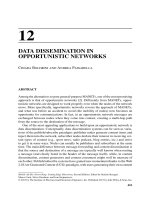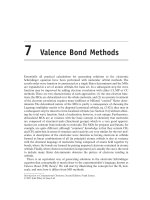Ebook Minimally invasive bariatric surgery (2nd edition): Part 1
Bạn đang xem bản rút gọn của tài liệu. Xem và tải ngay bản đầy đủ của tài liệu tại đây (8.75 MB, 200 trang )
Stacy A. Brethauer
Philip R. Schauer
Bruce D. Schirmer
editors
Minimally
Invasive Bariatric
Surgery
Second Edition
123
Minimally Invasive Bariatric
Surgery
wwwwwwww
Minimally Invasive Bariatric
Surgery
Second Edition
Editors
Stacy A. Brethauer, MD
Assistant Professor of Surgery
Cleveland Clinic Lerner College of Medicine
Bariatric and Metabolic Institute
Cleveland Clinic
Cleveland, OH, USA
Philip R. Schauer, MD
Professor of Surgery
Cleveland Clinic Lerner College of Medicine
Director, Bariatric and Metabolic Institute
Cleveland Clinic
Cleveland, OH, USA
Bruce D. Schirmer, MD
Stephen H. Watts Professor of Surgery
Department of Surgery Health Sciences Center
University of Virginia Health System
Charlottesville, VA, USA
Editors
Stacy A. Brethauer, MD
Assistant Professor of Surgery
Cleveland Clinic Lerner College of Medicine
Bariatric and Metabolic Institute
Cleveland Clinic
Cleveland, OH, USA
Philip R. Schauer, MD
Professor of Surgery
Cleveland Clinic Lerner College of Medicine
Director, Bariatric and Metabolic Institute
Cleveland Clinic
Cleveland, OH, USA
Bruce D. Schirmer, MD
Stephen H. Watts Professor of Surgery
Department of Surgery
Health Sciences Center
University of Virginia Health System
Charlottesville, VA, USA
Videos to this book can be accessed at />ISBN 978-1-4939-1636-8
ISBN 978-1-4939-1637-5 (eBook)
DOI 10.1007/978-1-4939-1637-5
Springer New York Heidelberg Dordrecht London
Library of Congress Control Number: 2014956872
© Springer Science+Business Media New York 2011, 2015
This work is subject to copyright. All rights are reserved by the Publisher, whether the whole or part of the material is
concerned, specifically the rights of translation, reprinting, reuse of illustrations, recitation, broadcasting, reproduction
on microfilms or in any other physical way, and transmission or information storage and retrieval, electronic adaptation,
computer software, or by similar or dissimilar methodology now known or hereafter developed. Exempted from this
legal reservation are brief excerpts in connection with reviews or scholarly analysis or material supplied specifically
for the purpose of being entered and executed on a computer system, for exclusive use by the purchaser of the work.
Duplication of this publication or parts thereof is permitted only under the provisions of the Copyright Law of the
Publisher’s location, in its current version, and permission for use must always be obtained from Springer. Permissions
for use may be obtained through RightsLink at the Copyright Clearance Center. Violations are liable to prosecution
under the respective Copyright Law.
The use of general descriptive names, registered names, trademarks, service marks, etc. in this publication does not
imply, even in the absence of a specific statement, that such names are exempt from the relevant protective laws and
regulations and therefore free for general use.
While the advice and information in this book are believed to be true and accurate at the date of publication, neither
the authors nor the editors nor the publisher can accept any legal responsibility for any errors or omissions that may
be made. The publisher makes no warranty, express or implied, with respect to the material contained herein.
Printed on acid-free paper
Springer is part of Springer Science+Business Media (www.springer.com)
This book is dedicated to my wife, Geri, with love and thanks for her support.
BDS
To my wife, Pam, and our great kids, Katie, Anna, and Jacob for their
continued support and encouragement. Also, to my patients who give me the
privilege of helping them on their journey to a healthier life.
SAB
To my endearing wife Patsy, our jewels: Daniel, Aaron, Teresa, Isabella,
and all my patients who have taught me everything I know about bariatric
surgery.
PRS
wwwwwwww
Preface
It is truly amazing how rapidly the field of bariatric surgery has changed over the last two
decades. As we proudly present our second edition of this text, it is clear that much has changed
in our field even since the first edition was published. The obesity and diabetes epidemic that
is upon us has spurred a sense of urgency among bariatric surgeons to provide safe and effective treatment to as many patients as possible and to educate our referring physicians about the
benefits of these metabolic procedures. There is still much work to be done to provide even
better access to patients and to ensure high quality care at a national level, but there are few, if
any, disciplines in surgery that have come so far in such a short time as bariatric surgery. The
morbidity and mortality rates after laparoscopic bariatric surgery are now equivalent to many
other commonly performed elective operations such as hysterectomy, hip replacement, and
cholecystectomy. That is a remarkable accomplishment that reflects the impact of laparoscopic
techniques, advanced training programs, and an emphasis on quality patient care that have
been the hallmarks of bariatric surgery since the 1990s.
This new edition highlights many of the advances in our field over the last 7 years with
regard to the multidisciplinary management of the obese patients and surgical outcomes.
Updated chapters on the medical and perioperative management of these patients provide
state-of-the-art management pathways to guide practicing bariatric physicians and surgeons.
Quality improvement, value-based care, and outcome reporting have entered the lexicon of
every practicing surgeon now, and we have also added an important chapter on patient safety
and quality improvement for the bariatric surgery program.
A major shift that has occurred in bariatric surgery over the last decade has been the acceptance of sleeve gastrectomy as a primary bariatric procedure. As sleeve gastrectomy surpasses
gastric bypass in the United States as the most commonly performed procedure, there is still
much debate about the long-term role of this relative newcomer to our field. This updated text
incorporates current updates on techniques, outcomes, and management of complications after
sleeve gastrectomy to address the successes and challenges of this operation. New investigative
techniques and procedures, both surgical and endoscopic, comprise a small proportion of clinical activity currently, but are discussed in this update as these concepts may hold promise for
less-invasive and more widely accepted interventions in the future.
This second edition provides surgical technique chapters written by leaders in the field
accompanied by updated illustrations and videos to inform the resident or fellow preparing for
the next day’s case. Outcome chapters for each procedure reflect the current state of the evidence and the text also provides practical management strategies for complications that occur
after each procedure accompanied by figures and images that illustrate these clinical
challenges.
As the emphasis on weight loss after these operations has been overtaken by the discussion
regarding metabolic benefits, we have added new chapters and authors to provide clear
vii
viii
Preface
evidence-based updates focusing on the long-term effects of bariatric surgery on mortality,
cancer, and the full spectrum of obesity-related comorbidities.
While it seems that change is the only certainty in the field of bariatric surgery, this updated
textbook provides the most current snapshot of this exciting and evolving field. We hope you
find the second edition of Minimally Invasive Bariatric Surgery a useful tool in your practice
and a practical guide to educating residents and fellows.
Cleveland, OH, USA
Cleveland, OH, USA
Charlottesville, VA, USA
Stacy A. Brethauer, M.D.
Philip R. Schauer, M.D.
Bruce D. Schirmer, M.D.
Contents
1
The Global Burden of Obesity and Diabetes ........................................................
John B. Dixon
2
Pathophysiology of Obesity Comorbidity:
The Effects of Chronically Increased Intra-abdominal Pressure .......................
Harvey J. Sugerman
1
7
3
Medical Management of Obesity ...........................................................................
Bartolome Burguera and Joan Tur
15
4
History of Bariatric and Metabolic Surgery ........................................................
Adrian G. Dan and Rebecca Lynch
39
5
Developing a Successful Bariatric Surgery Program ..........................................
Andrew S. Wu and Daniel M. Herron
49
6
Essential Bariatric Equipment: Making Your Facility
More Accommodating to Bariatric Surgical Patients..........................................
Hector Romero-Talamas and Stacy A. Brethauer
61
7
Patient Selection: Pathways to Surgery ................................................................
Monica Dua, Eric P. Ahnfeldt, and Derrick Cetin
75
8
The Role of Behavioral Health in Bariatric Surgery ...........................................
Leslie J. Heinberg and Janelle W. Coughlin
83
9
Operating Room Positioning, Equipment, and Instrumentation
for Laparoscopic Bariatric Surgery ......................................................................
Stacy A. Brethauer and Esam S. Batayyah
93
10
Anesthesia for Minimally Invasive Bariatric Surgery .........................................
Cindy M. Ku and Stephanie B. Jones
107
11
Postoperative Pathways in Minimally Invasive Bariatric Surgery ....................
Rebecca Lynch, Debbie Pasini, and Adrian G. Dan
115
12
Bariatric Surgery: Patient Safety and Quality Improvement ............................
John M. Morton and Dan E. Azagury
121
ix
x
Contents
13
Data Management for the Bariatric Surgery Program .......................................
M. Logan Rawlins
127
14
Sleeve Gastrectomy: Technique, Pearls, and Pitfalls ...........................................
Cheguevara Afaneh and Alfons Pomp
137
15
Laparoscopic Sleeve Gastrectomy: Outcomes .....................................................
Stacy A. Brethauer and Esam S. Batayyah
143
16
Laparoscopic Sleeve Gastrectomy: Management of Complications ..................
Pornthep Prathanvanich and Bipan Chand
151
17
Sleeve Gastrectomy as a Revisional Procedure ....................................................
Raul J. Rosenthal
171
18
Laparoscopic Gastric Plication ..............................................................................
Almino Cardoso Ramos, Lyz Bezerra Silva, Manoel Galvao Neto,
and Josemberg Marins Campos
179
19
Laparoscopic Adjustable Gastric Banding: Technique .......................................
George Fielding
187
20
Laparoscopic Adjustable Gastric Banding: Outcomes .......................................
Jaime Ponce and Wendy A. Brown
193
21
Laparoscopic Adjustable Gastric Banding: Long-Term Management ..............
Christine Ren Fielding
199
22
Laparoscopic Adjustable Gastric Banding: Management
of Complications......................................................................................................
Paul O’Brien
23
Laparoscopic Adjustable Gastric Banding: Controversies ................................
George Fielding
24
Gastric Bypass: Transoral Circular-Stapled
Gastrojejunostomy Technique ..............................................................................
Abdulrahim AlAwashez and Matthew Kroh
25
Gastric Bypass: Transgastric Circular Stapler Technique ..................................
Jaisa Olasky and Daniel B. Jones
26
Laparoscopic Gastric Bypass: Hand-Sewn
Gastrojejunostomy Technique ...............................................................................
Kelvin D. Higa and Cyrus Moon
209
219
227
235
239
27
Laparoscopic Gastric Bypass Using Linear Stapling Technique ........................
Bruce D. Schirmer
249
28
Outcomes After Laparoscopic Gastric Bypass .....................................................
Bruce D. Schirmer
255
29
Laparoscopic Gastric Bypass: Management of Complications ..........................
Emanuele Lo Menzo, Samuel Szomstein, and Raul J. Rosenthal
261
xi
Contents
30
Gastric Bypass as a Revisional Procedure ............................................................
Luigi Angrisani and Michele Lorenzo
271
31
Laparoscopic Gastric Bypass: Nutritional Management After Surgery ...........
Kelli C. Hughes, Rebecca N. Puffer, and Mary B. Simmons
277
32
Laparoscopic Malabsorptive Procedures:
Technique of Duodenal Switch...............................................................................
Giovanni Dapri, Guy-Bernard Cadière, and Jacques Himpens
33
Laparoscopic Malabsorption Procedures: Outcomes..........................................
Mitchell S. Roslin and Robert Sung
34
Laparoscopic Malabsorption Procedures:
Management of Surgical Complications ...............................................................
Fady Moustarah, Frédéric-Simon Hould, Simon Marceau,
and Simon Biron
35
Laparoscopic Malabsorption Procedures: Management
of Nutritional Complications After Biliopancreatic Diversion ...........................
Fady Moustarah and Frédéric-Simon Hould
289
299
309
323
36
Alternative Minimally Invasive Options: Neural Modulation............................
Sajani Shah, Elizabeth A. Hooper, and Scott A. Shikora
335
37
Intragastric Balloon ................................................................................................
Manoel Galvao Neto, Josenberg Marins Campos, and Lyz Bezerra Silva
343
38
Alternative Minimally Invasive Options: Endoluminal
Bariatric Procedures ...............................................................................................
Nitin Kumar and Christopher C. Thompson
39
Innovative Metabolic Operations ..........................................................................
Ricardo Cohen, Pedro Paulo Caravatto, and Tarissa Petry
40
Venous Thrombosis and Pulmonary Embolism in the Bariatric
Surgery Patient........................................................................................................
Brandon T. Grover and Shanu N. Kothari
353
363
371
41
Role of Flexible Endoscopy in the Practice of Bariatric Surgery .......................
Andrea Zelisko and Matthew Kroh
383
42
Bariatric Surgery in Adolescents ...........................................................................
Sean J. Barnett, Marc P. Michalsky, and Thomas H. Inge
401
43
Bariatric Surgery in the Elderly ............................................................................
Elizabeth A. Hooper, Bamdad Farhad, and Julie J. Kim
411
44
The High-Risk Bariatric Patient............................................................................
Eric Ahnfeldt, Monica Dua, and Derrick Cetin
417
45
Long-Term Mortality After Bariatric Surgery.....................................................
Aaron D. Carr and Mohamed R. Ali
423
xii
Contents
46
Gastroesophageal Reflux Disease in the Bariatric Surgery Patient ...................
Maria Altieri and Aurora Pryor
433
47
Gallbladder and Biliary Disease in Bariatric Surgery Patients..........................
Mohammad H. Jamal and Manish Singh
441
48
Effects of Bariatric Surgery on Diabetes ..............................................................
Ashwin Soni, Alpana Shukla, and Francesco Rubino
447
49
Cardiovascular Disease in the Bariatric Surgery Patient ...................................
Amanda R. Vest and James B. Young
455
50
Obesity and Cancer with Emphasis on Bariatric Surgery ..................................
Ted D. Adams, Steven C. Hunt, Lance E. Davidson, and Mia Hashibe
471
51
Obstructive Sleep Apnea in Bariatric Surgery Patients ......................................
Christopher R. Daigle and Stacy A. Brethauer
485
52
Ventral Hernias in the Bariatric Patient ...............................................................
Krzysztof J. Wikiel and George M. Eid
491
53
Plastic Surgery Following Weight Loss.................................................................
Dennis Hurwitz
497
54
The Female Patient: Pregnancy and Gynecologic Issues
in the Bariatric Surgery Patient ............................................................................
Karina A. McArthur, Giselle G. Hamad, and George M. Eid
507
Medicolegal Issues: The Pitfalls and Pratfalls
of the Bariatric Surgery Practice...........................................................................
Kathleen M. McCauley
513
55
Index .............................................................................................................. 523
Contributors
Ted D. Adams, Ph.D., M.P.H
Division of Cardiovascular Genetics, University of Utah School of Medicine, Salt Lake City,
UT, USA
Health & Fitness Institute, Intermountain Healthcare, University of Utah School of Medicine,
Salt Lake City, UT, USA
Cheguevara Afaneh, M.D.
Department of Surgery, New York Presbyterian Hospital, Weill Cornell Medical Center, New
York, NY, USA
Eric P. Ahnfeldt, D.O.
Cleveland Clinic Foundation, Bariatric and Metabolic Institute, Cleveland, OH, USA
Abdulrahim AlAwashez, M.D., M.B.B.S., F.R.C.S.C.
Department of Surgery, Dalhousie University, St. Marha’s Hospital, Antigonish, NS, Canada
Mohamed R. Ali, M.D.
Minimally Invasive and Bariatric Surgery, University of California, Davis Medical Center,
Sacramento, CA, USA
Maria Altieri, M.D.
Department of General Surgery, Stony Brook University Hospital, Stony Brook, NY, USA
Luigi Angrisani, M.D.
Surgical Endoscopy, S. Giovanni Bosco Hospital, Naples, Italy
Dan E. Azagury, M.D.
Section of Bariatric and Minimally Invasive Surgery, Stanford University School of Medicine,
Stanford, CA, USA
Sean J. Barnett
Cincinatti Children’s Hospital Medical Center, Pediatric and General Thoracic Surgery,
Cincinatti, OH, USA
Esam S. Batayyah, M.D., F.A.C.S.
Bariatric and Metabolic Institute, Cleveland Clinic, Digestive Disease Institute, Cleveland,
OH, USA
xiii
xiv
Simon Biron, M.D., M.Sc.
Department of Surgery, IUCPQ (Hospital Laval), Quebec, QC, Canada
Stacy A. Brethauer, M.D.
Bariatric and Metabolic Institute, Cleveland Clinic, Digestive Disease Institute, Cleveland,
OH, USA
Wendy A. Brown, M.B.B.S. (Hons), Ph.D., F.A.C.S., F.R.A.C.S.
Monash University Centre for Obesity Research and Education, Melbourne, VIC, Australia
Bartolome Burguera, M.D., Ph.D.
Research Unit, Division of Endocrinology, IUNICS, Hospital Universitario Son Espases,
Palma de Mallorca, Spain
Guy-Bernard Cadière, M.D., Ph.D.
Department of Gastrointestinal Surgery, European School of Laparoscopic Surgery, SaintPierre University Hospital, Brussels, Belgium
Josemberg Marins Campos, M.D., Ph.D.
Department of General Surgery, Universidade Federal de Pernambuco, Recife, PE, Brazil
Pedro Paulo Caravatto, M.D.
The Center of Obesity and Diabetes, Hospital Oswaldo Cruz, São Paulo, Brazil
Aaron D. Carr, M.D.
Minimally Invasive and Bariatric Surgery, University of California, Davis Medical Center,
Sacramento, CA, USA
Derrick Cetin, M.D.
Department of Bariatric Medicine, Cleveland Clinic Foundation, Bariatric Metabolic Institute,
Cleveland, OH, USA
Bipan Chand
Department of Surgery, Stritch School of Medicine, Loyola University Chicago, Chicago, IL,
USA
Ricardo Cohen, M.D.
The Center of Obesity and Diabetes, Hospital Oswaldo Cruz, São Paulo, Brazil
Janelle W. Coughlin, Ph.D.
Johns Hopkins University School of Medicine, Baltimore, MD, USA
Christopher R. Daigle, M.D.
Bariatric and Metabolic Institute, Cleveland Clinic, Cleveland, OH, USA
Adrian G. Dan, M.D. F.A.C.S.
Department of General Surgery, Akron City Hospital Summa Health System, Akron, OH, USA
Giovanni Dapri, M.D., Ph.D., F.A.C.S., F.A.S.M.B.S.
Department of Gastrointestinal Surgery, European School of Laparoscopic Surgery,
Saint-Pierre University Hospital, Brussels, Belgium
Lance E. Davidson, Ph.D.
Division of Cardiovascular Genetics, University of Utah School of Medicine, Salt Lake City,
UT, USA
Contributors
xv
Contributors
John B. Dixon, M.B.S.B., Ph.D., F.R.A.C.G.P., F.R.C.P. (Edin)
Baker IDI Heart & Diabetes Institute, Clinical Obesity Research, Melbourne, VIC, Australia
Monica Dua, M.D.
Cleveland Clinic Foundation, Bariatric and Metabolic Institute, Cleveland, OH, USA
George M. Eid
Allegheny Health Network, Pittsburgh, PA, USA
Bamdad Farhad, D.O.
Department of Bariatric and Minimally Invasive Surgery, South Eastern Medical Center,
Lumberton, NC, USA
George Fielding, M.D., M.B.B.S., F.R.A.C.S., F.R.C.S. (Glasgow)
Department of Surgery, New York University, New York, NY, USA
Christine Ren Fielding, M.D. F.A.C.S.
NYU Langone Medical Center, New York, NY, USA
Brandon T. Grover, D.O., F.A.C.S.
Department of General & Vascular Surgery, Gundersen Lutheran Health System, La Crosse,
WI, USA
Giselle G. Hamad
Department of Surgery, University Pittsburgh Medical Center, Pittsburgh, PA, USA
Mia Hashibe, Ph.D., M.P.H.
Department of Family and Preventive Medicine, University of Utah School of Medicine, Salt
Lake City, UT, USA
Leslie J. Heinberg, Ph.D.
Cleveland Clinic Lerner College of Medicine, Bariatric and Metabolic Institute, Cleveland
Clinic, Cleveland, OH, USA
Daniel M. Herron, M.D., F.A.C.S.
Department of Surgery, Mount Sinai School of Medicine, New York, NY, USA
Kelvin D. Higa, M.D.
Minimally Invasive Bariatric Surgery, Fresno Heart and Surgical Hospital, Fresno, CA, USA
Jacques Himpens, M.D., Ph.D.
Department of Gastrointestinal Surgery, European School of Laparoscopic Surgery, SaintPierre University Hospital, Brussels, Belgium
Elizabeth A. Hooper, M.D.
General and Bariatric Surgery, Mercy Clinic and Hospital, Oklahoma City, OK, USA
Frédéric-Simon Hould, M.D., F.R.C.S.C.
Department of Surgery, Advanced Laparoscopy, Bariatric and Metabolic Surgery, Institut
Universitaire de Cardiologie et de Pneumologie de Québec (IUCPQ), Laval University, Québec
City, QC, Canada
Kelli C. Hughes, R.D., C.D.E.
University of Virginia Health System, Charlottesville, VA, USA
xvi
Steven C. Hunt, Ph.D.
Division of Cardiovascular Genetics, University of Utah School of Medicine, Salt Lake City,
UT, USA
Dennis Hurwitz
UPMC Magee Women’s Hospital—Plastic Surgery, University of Pittsburgh, Pittsburgh, PA, USA
Thomas H. Inge
Department of Pediatric and General Thoracic Surgery, Cincinatti Children’s Hospital Medical
Center, Cincinatti, OH, USA
Mohammad H. Jamal, M.B.Ch.B. (Hons), M.Ed., F.R.C.S.C.
Department of Surgery, Mubarak Teaching Hospital, Kuwait University, Kuwait City, Kuwait
Daniel B. Jones, M.D., M.S., F.A.C.S.
Department of General Surgery, Beth Israel Deaconess Medical Center, Boston, MA, USA
Stephanie B. Jones, M.D.
Department of Anesthesia, Critical Care and Pain Medicine, Beth Israel Deaconess Medical
Center and Harvard Medical School, Boston, MA, USA
Julie J. Kim, M.D.
Department of Surgery, Tufts Medical Center, Boston, MA, USA
Shanu N. Kothari, M.D., F.A.C.S.
Department of General & Vascular Surgery, Gundersen Lutheran Health System, La Crosse,
WI, USA
Matthew Kroh, M.D.
Digestive Disease Institute, Cleveland Clinic, Cleveland, OH, USA
Cindy M. Ku, M.D.
Department of Anesthesia, Critical Care, and Pain Medicine, Beth Israel Deaconess Medical
Center, Boston, MA, USA
Nitin Kumar, M.D.
Division of Gastroenterology, Brigham and Women’s Hospital/Harvard Medical School,
Boston, MA, USA
Michele Lorenzo, M.D., Ph.D.
UOML Distretto 56, ASL—NA3 Sud, Torre Annunziata, Italy
Rebecca Lynch, M.D.
General Surgery, Summa Akron City Hospital, Akron, OH, USA
Simon Marceau, M.D., F.R.C.S.C.
Department of Surgery, IUCPQ (Hospital Laval), Quebec, QC, Canada
Karina A. McArthur
Kaiser Permanente Mid Atlantic, Holy Cross Hospital, Pittsburgh, PA, USA
Kathleen M. McCauley
Goodman Allen & Filetti, PLLC, Glen Allen, VA, USA
Contributors
xvii
Contributors
Emanuele Lo Menzo, M.D.
Department of General Surgery, Cleveland Clinic Florida, The Bariatric and Metabolic
Institute, Weston, FL, USA
Marc P. Michalsky
Nationwide Children’s Hospital, Columbus, OH, USA
Cyrus Moon, MD
Minimally Invasive Bariatric Surgery, Fresno Heart and Surgical Hospital, Fresno, CA, USA
John M. Morton, M.D., M.P.H.
Section of Bariatric and Minimally Invasive Surgery, Stanford University School of Medicine,
Stanford, CA, USA
Fady Moustarah, M.D., M.P.H., F.R.C.S.C.
Department of Surgery, IUCPQ (Hospital Laval), Quebec, QC, Canada
Manoel Galvao Neto, M.D.
Department of Bariatric Endoscopy, Gastro Obeso Center, São Paulo, Brazil
Paul O’Brien, M.D.
Centre for Obesity Research and Education (CORE), Monash Medical School, Monash
University, Melbourne, VIC, Australia
Jaisa Olasky, M.D.
Department of Surgery, Beth Israel Deaconess Medical Center, Boston, MA, USA
Debbie Pasini, R.N., B.S.N., C.B.N.
Bariatric Care Center, Summa Health System, Akron, OH, USA
Tarissa Petry, M.D.
The Center of Obesity and Diabetes, Hospital Oswaldo Cruz, São Paulo, Brazil
Alfons Pomp, M.D., F.A.C.S., F.R.C.S.C.
Department of Surgery, New York Presbyterian Hospital, Weill Cornell Medical Center,
New York, NY, USA
Jaime Ponce, M.D., F.A.C.S., F.A.S.M.B.S.
Hamilton Medical Center—Dalton Surgery Group, Dalton, GA, USA
Pornthep Prathanvanich
Department of Surgery, Stritch School of Medicine, Loyola University Chicago, Chicago,
IL, USA
Aurora Pryor, M.D.
Department of General Surgery, Stony Brook University Hospital, Stony Brook, NY, USA
Rebecca N. Puffer, M.P.H., R.D.
University of Virginia Health System, Charlottesville, VA, USA
Almino Cardoso Ramos
Department of Bariatric Surgery, Gastro Obeso Center, São Paulo, Brazil
xviii
M. Logan Rawlins, M.D.
Minimally Invasive & Bariatric Surgery, Department of Surgery, University of Virginia,
Charlottesville, VA, USA
Hector Romero-Talamas, M.D.
Bariatric and Metabolic Institute, Cleveland Clinic, Cleveland, OH, USA
Raul J. Rosenthal, M.D.
Bariatric and Metabolic Institute, Cleveland Clinic, Weston, FL, USA
Mitchell S. Roslin, M.D.
Department of Surgery, Lenox Hill Hospital, New York, NY, USA
Francesco Rubino, M.D.
Section of Gastrointestinal Metabolic Surgery, Department of Surgery, Weill Cornell Medical
College and New York Presbyterian Hospital, New York, NY, USA
Catholic University, Rome, Italy
Bruce D. Schirmer, M.D.
Department of Surgery, University of Virginia Health Systems, Charlottesville, VA, USA
Sajani Shah, M.D.
Department of Surgery, Tufts Medical Center, Boston, MA, USA
Scott A. Shikora, M.D.
Department of Surgery, Center of Metabolic & Bariatric Surgery, Brigham & Women’s
Hospital, Boston, MA, USA
Alpana Shukla, M.D., M.R.C.P.
Section of Gastrointestinal Metabolic Surgery, Department of Surgery, Weill Cornell Medical
College and New York Presbyterian Hospital, New York, NY, USA
Catholic University, Rome, Italy
Lyz Bezerra Silva, M.D.
Department of General Surgery, Hospital Agamenon Magalhães, Recife, PE, Brazil
Mary B. Simmons, R.D.
Rockingham Memorial Hospital, Harrisonburg, VA, USA
Manish Singh, M.D.
Bariatric and Metabolic Institute in Affiliation with Cleveland Clinic Bariatric and Metabolic
Institute, Doctors Hospital at Renaissance, Edinburg, TX, USA
Ashwin Soni, M.D., B. Sc.
Section of Gastrointestinal Metabolic Surgery, Department of Surgery, Weill Cornell Medical
College and New York Presbyterian Hospital, New York, NY, USA
Catholic University, Rome, Italy
Harvey J. Sugerman, M.D.
Department of Surgery, Virginia Commonwealth University, Sanibel, FL, USA
Robert Sung, M.D.
Department of Surgery, Lenox Hill Hospital, New York, NY, USA
General SurgeryLenox Hill Hospital, New York, NY, USA
Contributors
xix
Contributors
Samuel Szomstein, M.D.
Department of General and Vascular Surgery, Cleveland Clinic Florida, Weston, FL, USA
Christopher C. Thompson, M.D., M.Sc., F.A.C.G., F.A.S.G.E.
Division of Gastroenterology, Brigham and Women’s Hospital/Harvard Medical School,
Boston, MA, USA
Joan Tur, B.S., M.H.S., Ph.D.
Research Unit, Division of Endocrinology, IUNICS, Hospital Universitario Son Espases,
Palma de Mallorca, Spain
Amanda R. Vest, M.B.B.S., M.R.C.P.
Heart and Vascular Institute, Cleveland Clinic, Cleveland, OH, USA
Krzysztof J. Wikiel
Department of Surgery, Magee-Women’s Hospital of UPMC, Pittsburgh, PA, USA
Andrew S. Wu, M.D.
Department of Metabolic, Endocrine, and Minimally Invasive Surgery, Mount Sinai School of
Medicine, New York, NY, USA
James B. Young, M.D., F.A.C.C.
Heart and Vascular Institute, Cleveland Clinic, Cleveland, OH, USA
Andrea Zelisko, M.D.
Cleveland Clinic Lerner College of Medicine, Digestive Disease Institute, Cleveland, OH,
USA
1
The Global Burden of Obesity and Diabetes
John B. Dixon
One could only wonder what aliens who visited Earth briefly
40 years ago and returned today would think of the changes
seen in the dominant intelligent life form inhabiting the
planet. Large numbers of humans have become quite bloated,
sluggish, and many have difficulty getting around. This
would appear the most obvious change in the human condition during that period. What has happened? What has gone
wrong? What will things be like should our visitors return in
another 40 years?
The obesity-diabetes epidemic has rolled out progressively and inexorably since the 1970s, and little has been
done globally to prevent it. The causes are poorly understood, and any attempts to change the trends appear piecemeal, tokenistic, and ineffective. Regions of the developing
world that appeared to be protected with their economic and
lifestyle characteristics are surpassing all expectations, and
even those in rural areas of developing countries are running
head first into the diabesity epidemic.
Obesity a Global Issue: The global age-standardized prevalence of obesity nearly doubled from 6.4 % in 1980 to 12.0 %
in 2008. Half of this rise occurred in the 20 years between
1980 and 2000 and half occurred in the 8 years between 2000
and 2008 [1]. The magnitude of rise has varied with region,
country, and gender; however, stabilization of the obesity
prevalence is rare, and of great concern, the rise has accelerated globally over the last decade. In 1980, half of the 572
million adults with a BMI >25 kg/m2 lived in just five countries headed by China 72 million and the USA 70 million. In
2008, countries with the most overweight people were China
(241 million) and the USA (158 million). The largest absolute rise in obesity (BMI >30 kg/m2) occurred in the USA
(56 million) and China (42 million), followed by Brazil
(20 million) and Mexico (18 million). The region with the
highest global prevalence of obesity includes small islands in
the Western Pacific such as Nauru, Samoa, Tonga, and the
Cook Islands where obesity rates exceed 50 % and for some
subgroups 70 % [1].
Of the high-income nations, there were divergent trends for
both men and women with greater rises in obesity prevalence in
Australasia and North America compared with Western Europe
and high-income areas of Asia. Women had greater increases in
obesity prevalence than men in sub-Saharan Africa and Latin
America and the Caribbean. Men had greater a increase in
prevalence throughout Europe and the high-income regions of
the Asia-Pacific region [1]. “If the rates of weight gain
(in Australia) observed in the first 5 years of this decade are
maintained, our findings suggest that normal-weight adults will
constitute less than a third of the population by 2025, and the
obesity prevalence will have increased by 65 %” [2].
With increasing levels of obesity, we see an exponential
rise in class III obesity (BMI > 40 kg/m2). In the USA between
2000 and 2005, the prevalence of obesity increased by 24 %,
class III obesity by 50 %, and BMI >50 kg/m2 by 75 %, two
and three times faster, respectively [3]. Similar trends are
reported in Australia [4]. The resultant exponential increase
in class III obesity and super obesity is an expected trend as
the mean BMI for a community steadily increases. There is
also an important gender trend with increasing levels of
obesity with women more likely to have the more severe
forms of obesity Table 1. Scattered reports of a leveling off of
obesity prevalence in small subsections of the community,
for example, in adolescent and young adult women, should be
treated cautiously as levels are still high, and we need to reflect
about the weight trajectories of their mothers and grandmothers who at an equivalent age were generally more petite.
For years we have watched as the US CDC state by state
obesity levels have risen year by year and reassured ourselves that either our state was not the worst or, better still,
we lived outside the USA and were immune to the catastrophe within. But alas, we can now watch similar changes in
the Canadian provinces and UK counties, and thanks to the
International Association for the Study of Obesity (IASO),
we have a global atlas of the emerging trends. Sadly no
global area is or will remain immune.
S.A. Brethauer et al. (eds.), Minimally Invasive Bariatric Surgery,
DOI 10.1007/978-1-4939-1637-5_1, © Springer Science+Business Media New York 2015
1
2
J.B. Dixon
TABLE 1. Estimates of the proportion of the US adult population with a BMI > 40 kg/m2
Women (USA)
Men (USA)
1960 (%)
1980 (%)
2000 (%)
2010 (%)
1.4
0.4
2.8
0.8
6.1
2.9
7.4
4.3
Adapted from the IASO website [5]
Ethnic Differences Risk: Ethnic-Based
Action Points
Diabetes as a Global Issue: While it can be often assumed
that the emerging epidemic of type 2 diabetes parallels the
obesity epidemic, there are a range of other important considerations that influence the global and regional incidence,
prevalence, and total burden of type 2 diabetes.
The International Diabetes Federation “World Diabetes
Atlas” updated in 2012 provides an excellent overview of the
global situation, and there are very important regional considerations. Globally it is estimated that 371 million live with
diabetes, an overall adult prevalence is 8.3 %, and half of
these cases are undiagnosed:
• Countries with the highest prevalence of diabetes are in
two regions the Western Pacific Island nations and in the
Middle East. Examples of the highest prevalence rates in
adults include Federation of Micronesia (37 %), Nauru
(31 %), and Marshall Islands (27 %) in the Western Pacific
and Kuwait (24 %), Saudi Arabia (23 %), and Qatar
(23 %) in the Middle East.
• Countries with the highest absolute numbers in descending order are China (92 million), India (63 million), the
USA (24 million), and Brazil (14 million). And the region
with the highest numbers is the Western Pacific with 132
million.
• Sub-Saharan Africa is the region with the highest level of
undiagnosed diabetes (80 %).
It is the Asian area that now contributes to more than 60 %
of the world’s population with diabetes where some of the
most dramatic increases in diabetes prevalence have occurred
over recent decades. All Asian countries have seen major rises
as the rapid socioeconomic growth and industrialization interact with populations that have a strong genetic and ethnic risk
of diabetes. Asians develop diabetes at a lower threshold of
environmental and anthropometric risk (BMI and waist circumference) [6]. Another striking characteristic of diabetes in
the Asian region is the striking narrowing of the urban–rural
divide in diabetes prevalence. While urbanization and industrialization were thought to drive increased risk of diabetes, it is
now clear that the rural areas are following very closely
behind. In the Shanghai region of China, urban diabetes prevalence rose from 11.5 to 14.1 % between 2002–2003 and 2009,
while the rural diabetes prevalence rose from 6.1 to 9.8 % during the same period [7]. The rapid rise in diabetes numbers in
China indicates a major public health problem that has
occurred in parallel with the massive changes in development
and gross domestic product [8].
A recent review of diabetes prevalence in the rural areas
of low- and middle-income countries revealed a quadrupling
of prevalence over the last 25 years. Diabetes prevalence
increased over time, from 1.8 % in 1985–1989, 5.0 % in
1990–1994, 5.2 % in 1995–1999, 6.4 % in 2000–2004, to
8.6 % for 2005–2010 [9]. However, this is only part of the
story as it is estimated that between 2010 and 2013, the number of adults with diabetes will increase by 69 % in developing countries, while the expected increase in developed
countries is 20 % [10]. The diabetes burden in developing
countries is also troubling as the increase in diabetes prevalence is dominated by the 40–59 age group, a time of productivity and employment, rather than being driven by aging as
is the case developed countries (Fig. 1) [10].
Factors influencing the number of people with diabetes
also vary considerable between developed and developing
countries. If the incidence of diabetes exceeds mortality, then
the prevalence rises. The absolute number of people with
diabetes will be influenced by a range of factors, and the
relative contributions of these factors vary considerably
(Fig. 2). An increased prevalence of diabetes is not simply
related to an increase incidence. In the period between 1999
and 2004 in Taiwan, the prevalence of diabetes increased
38 % and 24 % in men and women, respectively, but during
the same period, incidence dropped 4 % and 13 %, respectively. An increased incidence in younger adults and a
reduced incidence in the elderly increased prevalence substantially [11].
Diabetes incident and prevalence data from Ontario
Canada between 1995 and 2005 provides another example of
the interactions that lead to prevalence. During this period,
the age- and sex-adjusted prevalence of diabetes in the province increased 69 %, from 5.2 % in 1995 to 8.8 % in 2005.
The rate of increase in prevalence was greater in a younger
population and the mortality of those with diabetes fell by
25 %. Thus, the increased prevalence in diabetes is attributed
to both an increased incidence and improved survival [12].
The prevalence of diabetes in the USA is also greatly
influenced by an increased survival of those with diabetes.
During the period 1997 to 2004, the National Health
Interview Survey found that age-adjusted excessive death
rates for those with diabetes (compared with those without
diabetes) declined by 60 %, from 5.8 additional deaths/1000
to 2.3 additional deaths/1000, for cardiovascular disease, and
3
1. The Global Burden of Obesity and Diabetes
180
Developed
160
Number people with diebetes(millions)
FIG. 1. The predicted number
of people with diabetes in
2030 in comparison with 2010
(adapted from: Shaw, J.E. et al.,
Diabetes Res Clin Pract, (2010).
87(1): p. 4–14).
Developing
140
120
100
80
60
40
20
0
2010
2013
2010
20 - 39 years
FIG. 2. The reasons associated
with an increase in the numbers
with diabetes. The relative impact
of these population characteristic
varies considerably between
developed and developing
countries.
2013
40 - 59 years
2010
2013
60 - 79 years
Reasons for increasing numbers of
people with diabetes
Population
growth
Population
ageing
Increasing numbers
of people at risk
Increasing
numbers of
people with DM
Improved survival of
people with
diabetes
Worsening risk facto
profile:
Urbanization
Obesity
for all-cause age-adjusted mortality a decline of 44 % from
10.8 to 6.1 deaths/1000. The declines were similar in both
men and women [13]. Similar declines in mortality have
been reported in other developed countries including Canada,
Norway, and Finland. These encouraging findings have been
attributed to a range of advances including systematic
improvements in the quality and organization of care,
improved models of chronic disease management, and the
active promotion of self-care behaviors. More intensive
pharmacotherapy targeting optimal levels of blood pressure
[14] and cholesterol [15] has been shown to reduce morbidity and mortality, while the targets for glucose control remain
more controversial [16]. There have also been reductions in
smoking, limb amputations, and visual loss associated with
retinopathy.
It becomes clear that while increasing levels of obesity
play a major role in the increasing global population with
diabetes, there are other major contributing determinants.
The contrast in these determinants in developing compared
with developed nations is presented in Table 2.
Causes Are Complex: The global biological determinants
for the obesity-diabetes epidemic appear complex and poorly
understood. They extend well beyond the global marketing
of Westernized energy dense foods and the obligatory reduction in human movement that a developed society delivers.
The interaction with the environment is far more complex,
and a large number of additional conditions also appear to
contribute to the evolving catastrophe. This complexity may
partly explain the impotence of current preventative measures.
Early life and metabolic programming appear to be very
4
J.B. Dixon
TABLE 2. The differing determinants of the increasing population
with diabetes in developing compared with developed countries
Developed
Population growth
Population aging
Increasing high-risk ethnicities
Increased incidence
Falling mortality
+
+
++
+
++
Developing
++
+++
−
++
−
important factors contributing to obesity and may include
genetics, maternal age, assertive mating, childhood infections, the pattern of established gut microbiota, and epigenetic programming changes to the ovum, the fetus, and the
infant during the early years of life [17, 18]. The most important 4 years that influence a person’s weight throughout the
life cycle may well occur before the 3rd birthday. Early life
programming sets an organism up for the environment that
the organism is likely to encounter for living. To be programmed for a lean nutritional environment and being born
into the “land of plenty” is aberrant representing a clear
programming-environmental mismatch. One only has to
look at the obesity and metabolic plight of indigenous populations globally when confronted with Western living conditions. It may not surprise that people of European origin fare
best in “a land of plenty” and indeed may be the global
exceptions in their resistance to developing diabetes and
other metabolic disturbance associated with obesity.
Other environmental conditions are also likely to contribute to the obesity emidemic: sleep time over the decades has
been reduced and is partly replaced with screen time; temperature-controlled environments reduce our energy expenditure in both heating and cooling our bodies; endocrine
disrupters are widely dispersed within our environment and
some contribute to weight gain; antibiotics and other factors
have been designed to grow our food supply rapidly and efficiently may also change or gut microbiome to encourage
weight gain; and iatrogenic contributions to weight gain
through medications to treat mental illness, epilepsy, chronic
autoimmune and inflammatory disease, and diabetes [17].
Obesity and Its Influence on Diabetes
The risk of developing type 2 diabetes at any given BMI is
strongly related to ethnicity, and the World Health
Organization and the International Diabetes Federation recommend modified action points for interventions based on
ethnicity (Table 3).
Obesity also has additional influences on the number of
people with diabetes for reasons beyond increased incidence.
Obesity is leading to an onset of type 2 diabetes in younger
age groups. There is a negative relationship between BMI
and the age of onset of type 2 diabetes [19, 20], and this is
clearly associated with a longer period living with diabetes.
Life expectancy for diabetes diagnosed at 30 years is quite
different to that of 70 years.
In those with diabetes, overweight and obesity appears
to be associated with lower age-adjusted mortality.
A series of recent population assessments raise a very relevant issue with respect to diabetes, BMI, and mortality.
All are different populations, but there are consistent findings and all would raise substantive questions about the
value of weight loss in the overweight and class I obese
BMI ranges.
Data from 5 pooled analyses of 5 large US longitudinal
cohort studies were examined for incident diabetes in men
and women over the age of 40 years and subsequent cardiovascular and all-cause mortality. After adjusting for demographics and established cardiovascular risk factors, those
who were overweight and obese had a reduced all-cause and
cardiovascular mortality [21].
Similar and very confronting data has been reported from
Taiwan where a national diabetes registry is active [22].
Almost 90,000 diabetic patients were recruited after 1995
and the national death registry examined at the end of 2006
when 30 % had died. The adjusted analysis found that
increasing body mass index was associated with progressive
reduction in all-cause mortality. The effect was statistically
significant for all causes of mortality other than cancer
deaths. Those with a BMI >30 (which is uncommon in
Taiwan) had the lowest mortality. This is one example of the
obesity survival paradox.
A third study in Scotland examined BMI at the time of
diabetes diagnosis in over 100,000 patients and mortality.
There were 9,631 deaths between 2001 and 2007. BMI at the
time of diagnosis was associated in a U-shaped mortality
with the lowest index mortality in the overweight group.
The authors question if weight loss interventions reduce
mortality [23].
Black and Caucasian men followed by the USA VA
medical centers also demonstrate an inverse relationship
between BMI and diabetes mortality. The obese men, even
those with a BMI > 35, have a lower mortality than normalweight men [24].
These data add important contributions to the metabolic
surgery—type 2 diabetes debate and raise issues about
intentional weight loss in those not in the BMI > 35 category.
This emerging data, combined with the issues with the large
Sibutramine SCOUT study [25] and the premature cessation
of the Look Ahead study for lack of hard end-point efficacy,
all raise questions about any value in intentional weight loss
in the overweight and class I obese BMI range in those with
diabetes. It is becoming clear that bariatric-metabolic surgery will need to provide hard all-cause mortality, cardiovascular mortality, and suicide outcomes [26] data before it
could be a broadly acceptable therapy for overweight and
class I obese individual with diabetes. The same pattern has
emerged for the approval of pharmacotherapy for weight loss
and diabetes although it is easier to stop drug therapy than
reverse bariatric procedures.
In summary, diabetes and obesity prevalence continues to
rise, especially in the young and in developing countries.
5
1. The Global Burden of Obesity and Diabetes
TABLE 3. The classification of weight category by BMI
2
Classification
BMI (kg/m )
Principal cutoff points
Cutoff points for Asians
Normal range
18.5–24.9
Pre-obese
25.0–29.9
Obese class I
30.0–34.9
Obese class II
35.0–39.9
Obese class III
≥40.0
18.5–22.9
23.0–24.9
25.0–27.4
27.5–29.9
30.0–32.4
32.5–34.9
35.0–37.4
37.5–39.9
≥40.0
For Asian populations, classifications remain the same as the international
classification, but public health action points for interventions are set at 23,
27.5, 32.5, and 37.5 [27]
We address eligibility and prioritization for bariatric surgery within the
colored zones above
Source: Adapted from WHO 2004 [28]
(d) There is insufficient data to know how many in our communities have the more severe forms of obesity.
The answer is C.
Question 2
The increasing prevalence of diabetes in developed countries
such as the USA is related to:
(a) Increased aging
(b) Increased overweight and obesity rates
(c) Increased survival of those with diabetes
(d) Increased proportion within the population with a high
ethnic risk
(e) All of the above
The answer is E.
Question 3
Increasing obesity and its associated increase in incident
diabetes do not explain all the increase in diabetes prevalence, and the determinants of prevalence vary considerably
in developing countries when compared with developed. The
morbidity and mortality associated with diabetes has
decreased substantially in developed countries where the
major increase in diabetes is likely to occur in those over 60
years. In contrast in developing countries, the obesitydiabetes epidemic burden will impact those of working age.
Longitudinal epidemiological data indicates that overweight
and obesity may be associated with improved survival in
those with diabetes and that the benefits of intentional weight
loss are unclear.
The burden of obesity and diabetes remains high globally,
and national and regional obesity-diabetes prevention and
management strategies are essential.
Acknowledgment: I would like to thank Professor
Jonathan Shaw, at the Baker IDI Heart and Diabetes Institute,
Melbourne, for sharing figures and data that I have used in
the preparation of this chapter.
Review Questions and Answers
Question 1
What is the expected change in the proportion of people with
severe obesity (class II, III, and BMI > 50) as the prevalence of obesity rises in a community?
(a) The rise in the prevalence of obesity leads to the same
proportional rise in higher levels of obesity.
(b) The proportional rise in severe forms of obesity is less
than expected because limited numbers have the propensity to become severely and super obese.
(c) The proportional (or percentage) rises far more rapid
and becomes more so with higher BMI. The proportion
of super obese (BMI >50) is rising rapidly.
Which of the following is true about diabetes prevalence in
developing countries?
(a) Diabetes rates are much lower than in developed
countries.
(b) Diabetes rates are only rising in urban regions.
(c) The expected increase in diabetes will have its greatest
impact in the working years of middle age rather than
the elderly.
(d) The expected increase in diabetes will have its greatest
impact in elderly.
(e) Diabetes is not a major health issue in developing
countries as it is in the developed.
The answer is C.
References
1. Stevens GA, Singh GM, Lu Y, Danaei G, Lin JK, Finucane MM,
Bahalim AN, McIntire RK, Gutierrez HR, Cowan M, Paciorek CJ,
Farzadfar F, Riley L, Ezzati M. National, regional, and global
trends in adult overweight and obesity prevalences. Popul Health
Metr. 2012;10:22.
2. Walls HL, Magliano DJ, Stevenson CE, Backholer K, Mannan HR,
Shaw JE, Peeters A. Projected progression of the prevalence of obesity in Australia. Obesity (Silver Spring). 2012;20:872–8.
3. Sturm R. Increases in morbid obesity in the USA: 2000-2005.
Public Health. 2007;121:492–6.
4. Walls HL, Wolfe R, Haby MM, Magliano DJ, de Courten M, Reid
CM, McNeil JJ, Shaw J, Peeters A. Trends in BMI of urban
Australian adults. Public Health Nutr. 1980–2000;2009:1–8.
5. IASO. USA prevalence of morbid obesity—adapted from the IASO
website; 2013.
6. Ramachandran A, Snehalatha C, Shetty AS, Nanditha A. Trends in
prevalence of diabetes in Asian countries. World J Diabetes.
2012;3:110–7.
7. Li R, Lu W, Jiang QW, Li YY, Zhao GM, Shi L, Yang QD, Ruan Y,
Jiang J, Zhang SN, Xu WH, Zhong WJ. Increasing prevalence of
type 2 diabetes in Chinese adults in Shanghai. Diabetes Care.
2012;35:1028–30.
8. Yang W, Lu J, Weng J, Jia W, Ji L, Xiao J, Shan Z, Liu J, Tian H, Ji
Q, Zhu D, Ge J, Lin L, Chen L, Guo X, Zhao Z, Li Q, Zhou Z, Shan









